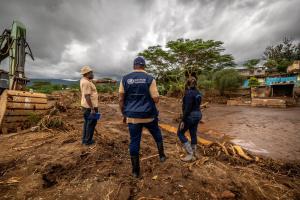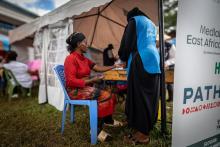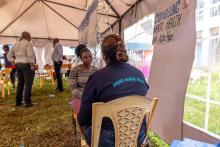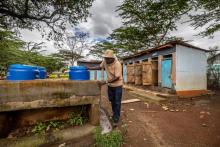Rapid response brings relief to flood-affected communities in Kenya
Nairobi ‒ This year’s long rainy season, which typically lasts from March to May every year, has hit Kenya hard, with unexpected heavy rainfall and widespread flooding since mid-April. Over 286 000 people have been affected, 47 000 households displaced and 238 deaths have been reported in 37 of the country’s 47 counties.
According to Dr Pius Mutuku, medical epidemiologist in the Ministry of Health, 14 health facilities have closed and a major water treatment plant has been affected by flooding, leading to a shortage of potable water for 3000 people. Forty-four cholera cases have been reported in Tana River County, one of the most flood-affected areas.
The Government of Kenya has mounted a multisectoral emergency response, led by the Kenya Disaster Emergency Operations Centre in the country’s capital, Nairobi. The centre gathers information from the 33 affected counties for analysis and decision making. At the national Public Health Emergency Operations Centre, around 36 staff are monitoring and leading the health situation and response, supported by World Health Organization (WHO) and other partners such as Kenya Red Cross Society, AMREF, FHI360 and Foundation for Professional Development. The Ministry of Health has set up an incident management system team for surveillance, case management, laboratory, logistics and risk communication and community engagement to monitor and manage disease outbreaks.
“The whole-of-government approach, led by President William Ruto, is to ensure that we work across all sectors to minimize the pain for so many,” says Hilary Limo, the manager of the Public Health Emergency Operations Centre.
The ministry has set up medical camps, with the support of Red Cross, for continuity of health services to over 4000 people who have been affected by health facility closure. Over 720 first responders, trained by WHO, are being deployed or on standby for deployment to flood-affected areas to provide health services to displaced people at the country’s 192 camps. More than 120 of Kenya’s public health professionals and experts, also trained by WHO are deployed at the national level.
“WHO will continue to support the health emergency response and remain vigilant for disease outbreaks that can easily spread if not quickly contained. We must be agile and ready to respond, led by government and along with the partners, to bring relief to hundreds and thousands of affected people,” says Dr Abdourahmane Diallo, WHO representative in Kenya.
WHO has also procured around 87 cholera, 58 interagency and 20 pneumonia kits that are being distributed to key counties and can treat around 10 000 people.
“Going forward we will need to look at the impact of the floods, continuity of care and provide resilience capacity building to communities. We need more rapid response teams and will work closely with partners to mobilize resources for this purpose,” says Limo.
Communications & Social Mobilisation
Tel: +254 722509403
Cell: +254 710 149489
Email: mwakishaj [at] who.int (mwakishaj[at]who[dot]int)
Communications and marketing officer
Tel: + 242 06 520 65 65 (WhatsApp)
Email: boakyeagyemangc [at] who.int (boakyeagyemangc[at]who[dot]int)








